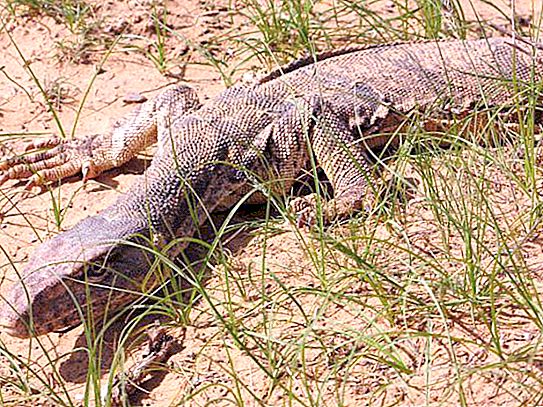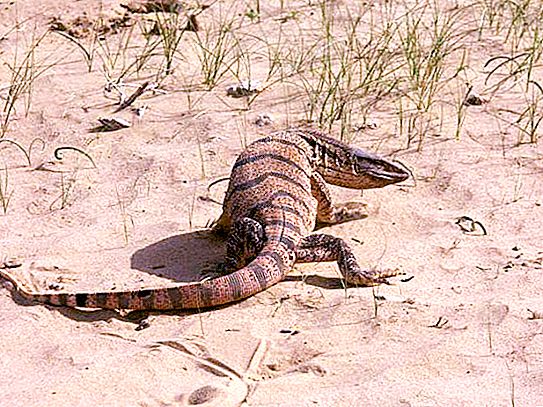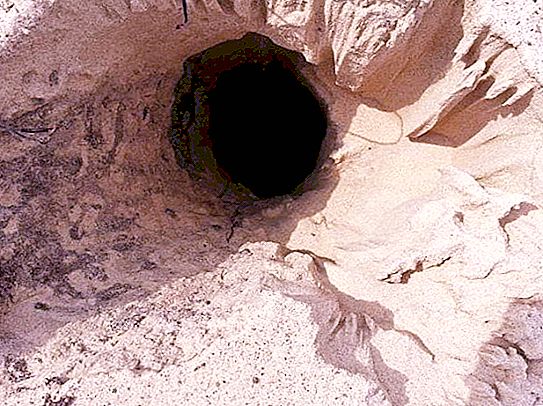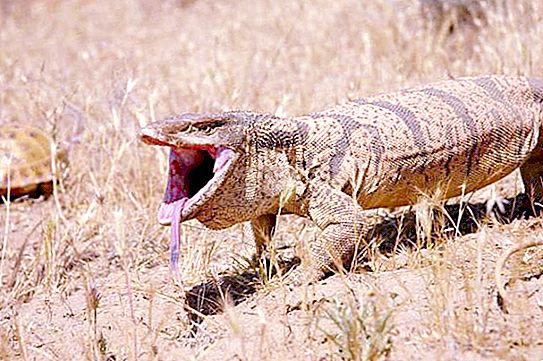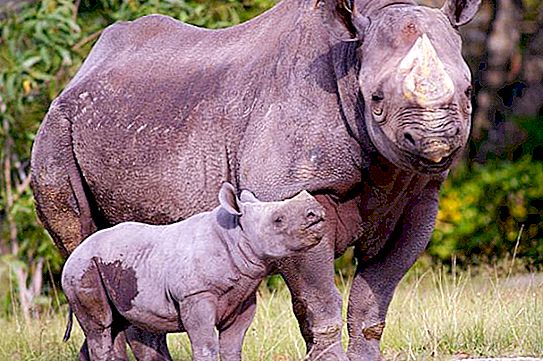Central Asian gray monitor lizard is an amazing creature. This is the largest lizard of the fauna of Central Asia. Representatives of the species are common in the territories of Afghanistan, Iran, Pakistan, Azerbaijan, Turkey. Gray lizards are also listed in the Red Book of IUCN and some of the listed countries. However, these are not the most interesting facts regarding these large lizards.
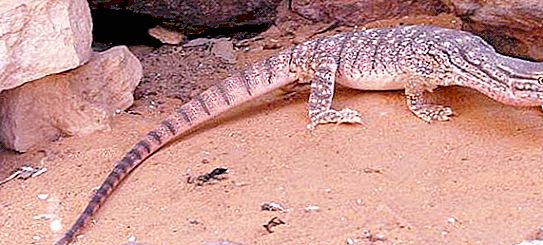
Color
Gray monitor lizard is a large creature. The maximum length of his body can reach one and a half meters. And the body, by the way, occupies only a third. The rest of the length is "occupied" by the tail. The maximum weight can reach 3.5 kg. But such cases are rare. Males, as is usually the case in the animal kingdom, are larger than females. However, not harder.
The gray monitor lizard, the photo of which is provided above, has a very interesting color. Although by ear, based on the name, it does not seem so. In fact, it seems more sandy or light brown than gray. Not without its numerous dark spots and specks, which "strewn" the upper body of these creatures. The neck is typically distinguished by 2-3 longitudinal dark stripes, which are connected at the back and seem to form a horseshoe-shaped pattern.
Interestingly, in "youth" the gray monitor lizard always looks brighter than at an older age. The general background of young individuals casts a yellow tint, and the dark stripes appear not brown, but almost black.
Physiology features
The oblique slit-like nostrils of these lizards are quite close to the eyes. Such a structure makes it easier for the monitor to study the holes, since the nostrils in the process are not blocked by sand. This is important, because the gray monitor lizard preys mainly on rodents that live in holes. Its victims are jerboas, ground squirrels, mice, field voles, gerbils. Sometimes, however, lizards prey on geckos, young snakes and turtles. In general, they have a rich diet. Sometimes these creatures even attack snakes and Central Asian cobras. However, about the hunt - a little later.
Gray monitor lizard - reptile, with strong sharp teeth, which are slightly bent back. With them he holds his victim. The teeth are constantly updated. Throughout life, a lizard erases several of their pairs. By the way, the teeth of the gray monitor lizard have no cutting edges. But despite this, he is still able to kill large animals and eat them, swallowing whole, however, not without effort.
Hunting
So, we have listed above what the gray monitor lizard eats. Now we can say a few words about exactly how this creature hunts.
If the lizard chose a large snake as a victim, it will adhere to certain tactics. First, she will tire her with false attempts to attack - she will make calls from different directions, like a mongoose. And then, when the snake gets tired, jumps on it and grabs its head (or a little further) with its teeth. Immediately, the lizard begins to shake the victim and hit it on the ground or stones. He needs the victim to stop resisting. Sometimes for this he can simply hold it in his teeth, clenching his jaw until the snake loosens. There will be nothing from the response (bite) to the monitor lizard. If the snake tries to “wrap” the hunter in a ring to strangle, he will easily dodge.
When the monitor lizard is hunting, it tries to adhere to the already proven route. During the "research" he checks the rodent burrows, bird nests, gerbil colonies. However, if nothing can be found, the reptile will not disdain carrion.
Habitat
The countries on the territory of which the gray monitor lizard may have already been listed above. The appearance features allow it to go unnoticed - it is ideally masked in the sand, and on the trees, and between stones, and in the ground. By the way, the northern border of the habitat reaches the coast of the Aral Sea without drainage (on the border of Uzbekistan and Kazakhstan). Most rarely, this lizard is found in the valley near the Central Asian river Syr Darya.
As a rule, gray lizards live in large numbers where many small mammals can be found. The Turkmen village of Garametniyaz is considered such a place. More precisely, the territory next to it - there, for every square kilometer, the density of gray monitor lizards is from 9 to 12 individuals.
Lifestyle
Deserts and semi-deserts - this is where the gray monitor lizard is most often found. What are the features of his appearance - it was said at the very beginning of the article, and with such a look he can easily hide from more predatory animals. Most often, these lizards can be found on semi-fixed or fixed sands, a little less often - on clay soils.
Lizards try to stick to river valleys, foothills, ravines, tugai thickets. And they can not be found in those areas where dense vegetation is observed. True, they visit rare woodlands. But certainly they will never live in those places adjacent to human dwellings.
Gray lizards hide in the same burrows where turtles and rodents used to live. They can “settle” in a hollow or bird's nest. But they are looking for finished housing, as a rule, in clay deserts. Since there it is difficult for them to dig their own hole. But in the sandy deserts - no. There, lizards dig holes, the depth of which can reach several meters. For the winter they hibernate there. And so that no one gets into the hole, they close it with a cork from the ground.
Activity
Varanov can be met only during the day, and then if the street is not too hot. If the thermometer reads off scale, the lizard will hide in the shelter. The normal temperature of their body is from 31.7 to 40.6 degrees maximum.
Lizards are pretty quick creatures. They move at a speed of 100-120 meters per minute. That is, they can overcome 7.2 kilometers in an hour - and this is one and a half times more than a person can walk in the usual step. Although these lizards travel only a little more than 10 kilometers per day. They move away from their burrows long distances, but always come back.
Lizards easily climb trees, often go into ponds. There is an assumption that they can mark their territory - this happens in summer and spring. However, not all biologists think so, so the fact is considered controversial.
Enemies
Gray monitor lizards practically do not have them, if we talk about the natural habitat. The only enemy of this lizard is man. Although young kites are often attacked by black kites, snake-eaters, jackals, Korsaks and Buzzards. Larger lizards can also attack the gray monitor lizard. And if he sees the danger, he will develop a speed of up to 20 km / h in order to break away from the pursuit. But if it doesn’t work out, it “swells”, becomes flat and wide, begins to hiss and protrude far out its long forked tongue. Which, by the way, is its additional olfactory organ.
If the enemy does not get scared and continues to advance, the lizard starts whipping its tail and rushing at the aggressor. It may bite, although this is the last trick he has resorted to. Because the teeth of a monitor lizard can cause severe pain, which entails an inflammatory reaction. Lizards are not toxic, but certain toxic components are present in their saliva.

